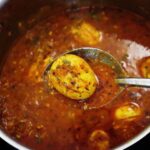Dhaba Style Egg Curry Recipe
This dhaba-style egg curry made with boiled eggs simmered in a spicy bhuna onion-tomato masala curry. One pot recipe with bold, rustic North Indian dhaba flavors. Here's how to make it with step by step photos and a recipe video.
Servings: 4 people
Calories: 311kcal
Equipment
- 1 Pot/Kadhai
Ingredients
For frying eggs
- 6 eggs, boiled and peeled
- 1 tablespoon oil
- ¼ teaspoon turmeric powder
- ½ teaspoon Kashmiri red chili powder
Crud/yogurt paste
- ½ cup Yogurt/curd
- Roasted gram flour
- 2 teaspoon Kasmiri red chili powder, add as per taste
- ¼ teaspoon turmeric powder
- ½ teaspoon garam masala powder
- ½ teaspoon pepper powder
- 3 teaspoon coriander powder
For egg curry
- 1 tablespoon oil
- 3 onions roughly chopped
- 2 green chilies
- 1 tablespoon chopped coriander stems
- 10-12 garlic cloves, small size, if bigger use 6-7
- 1- inch ginger, roughly chopped
- 3 tomatoes
- salt to taste
- 1 teaspoon cumin
- 2 green cardamoms, slightly crush before adding
- 4 cloves
- ½ inch cinnamon
- 1 egg (raw or uncooked)
- 1 green chili
- Handful of coriander leaves
Instructions
Preparations for the egg curry
- Roast kasuri methi on low heat until crisp and aromatic. Remove it to a plate and set aside.
- Roast besan on low heat until aromatic and light golden. Remove it to a plate and set aside.
- Prepare the curd or yogurt mixture by combining curd with Kashmiri red chili powder, turmeric powder, garam masala powder, pepper powder and coriander powder. Make sure there are no lumps in the mixture. Set aside.
- Finely chop the onions, ginger, garlic, and green chilies. Keep them aside.
- Finely chop/grate the tomatoes and keep them aside.
Frying the Eggs
- Heat 1 tablespoons of oil in a kadhai or deep pan over low heat.
- Add turmeric powder and Kashmiri red chili powder. Stir for a few seconds to prevent burning. Gently add the boiled eggs and stir-fry until they are golden brown. Keep the heat on low, or the spice powders will burn.
- Remove the eggs from the kadhai and set them aside.
Making the Dhaba Style Egg Curry
- Add the remaining 1 tablespoon of oil to the same kadhai.
- Add cumin seeds, green cardamoms (slightly crush it before adding), cloves, and cinnamon. Cook until the cumin seeds crackle.
- Add the chopped onion, ginger, garlic and green chilies. Bhuno the masala that means cook on medium heat until the onions turn golden brown. Be patient this will take around 10-12 minutes.
- Add the chopped tomatoes and salt. Cook for 4-5 minutes, or until the bhuna masala starts to release oil from the sides. Make sure the tomatoes are roasted well otherwise you will get raw flavor in the egg curry.
- Add the whisked curd/yogurt mixture to the kadhai. Stir continuously and cook for a few minutes. It will stick at the bottom of the kadhai so keep stirring continuously and cooking until oil separates. It will take 2-3 minutes. If necessary you can add a few splashes of water while roasting.
- Add 2 cups of hot water to adjust the consistency of the curry. Bring it to a boil.
- Add 1 raw egg to the curry. Stir continuously until it is fully combined and the curry thickens. Cover the kadhai with a lid and cook until oil floats on the surface of the curry.
- Add the kasuri methi, fried eggs, and additional green chilies. Cover and cook on low heat for 2 minutes to allow the flavors to combine.
- Garnish with chopped coriander leaves. Serve hot with Naan, roti, or rice.
Video
Notes
- Finely chop the onion, ginger, garlic, and green chilies. This way, they cook down easily and make a good base for the egg curry, giving it a texture like you find in dhaba-style curries, not a smooth paste. I used a vegetable chopper for this, but you can also use a knife.
- One thing I’ve learned from watching dhaba cooks is how patiently they fry the onions and other ingredients. They cook them slowly until they’re deep golden and almost jammy. This step, called bhuno, isn’t just about browning; it builds the flavor of the curry. The onions break down, soak up the spices, and create a rich base that makes the whole dish come alive. That slow-cooked flavor is what gives the dhaba-style curry its unique flavor.
- Dhaba-style cooking uses a good quantity of both whole and ground spices, often tempered in hot oil or ghee at different stages, which builds layers of flavor.
- A generous amount of oil or ghee is used in dhaba-style cooking. So, do not cut down the quantity of oil for authentic flavor.
- In traditional Indian cooking, a visible layer of oil (tari) on top is often seen as a sign of a well-cooked, rich, and satisfying curry. It also helps in preserving the dish slightly if left out for a short time.
Nutrition
Calories: 311kcal
